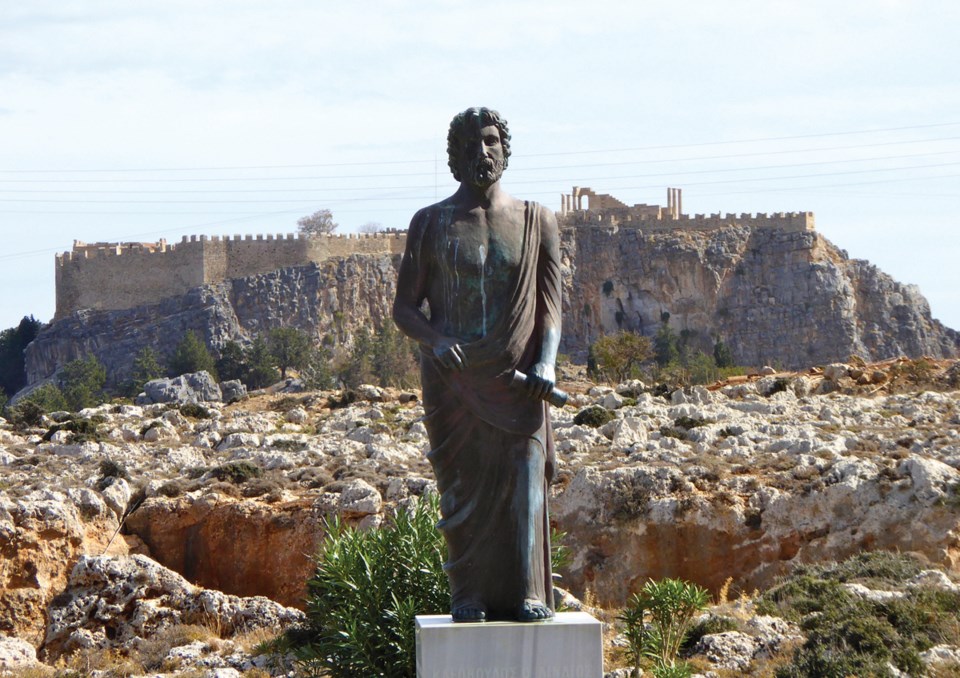From the medieval port of Rhodes, a Viking Star excursion shuttles us to point near an acropolis predating Athens’ own.
Stepping from the bus, guide Cora points out a bronze statue across the street. “That’s Cleoboulos, known as a benevolent tyrant,” says Cora. “Those marble columns rising from that distant mesa form the Acropolis of Lindos, his 6th century BC creation.”
Our stroll descends into the whitewashed village of Lindos. Beyond the main square, tethered donkeys await sightseers wishing to ride the steep route to the Acropolis. We walk onward, negotiating the colourful pebbled, but slippery laneways. Occasionally pausing, many of us sniff out open-air bistros, admire a little church and check out shop souvenirs.
A long, steep stairway takes us between sugar-cube captains’ houses and out of the village. Our ascent continues on a cliff-side pathway that spirals upward under shady cypress trees. Basking on rocks, cats of all kinds and colours observe our steady progress. Around one bend, embroidered shawls and tablecloths cover patches of grass. Lindos, we learn, has long marketed beautiful handcrafted textiles.
Passing through a stone gateway, we sight a massive trireme relief. “This Rhodian warship was carved into the rock in 180 BC. A General’s statue once stood on the prow,” Cora notes. “Looking above to the right, you’ll see 13th century Basilica of St. John.”
The knights’ stairway leads us up through another gate and into their castle’s small courtyard. “Votives were uncovered throughout the site. Pilgrims often brought terra-cotta statuettes to honour Athena, protector of women,” Cora explains. “Some refer to religious banquets and portray males reclining with drinking vessels. Animal figurines like lions praise Athena’s power over nature.” Passing through a dimly lit castle chamber, we see large bases for religious offerings bordering the walls.
Emerging onto a terrace, Cora points out the foundation of a temple dedicated to Roman Emperor Diocletian and an Ottoman era building. Forty-two lofty columns still outline the Hellenistic Portico’s 87-metre length. Cora tells us the Portico served as an art gallery and shelter for pilgrims. A plaque illustrates its grandeur and the magnificence of the monumental Propylaea above.
Its marble stairway still rises skyward, as if ascending to heaven. Climbing to the top, we try to imagine the pictured Propylaea. We learn its buildings, as the gateway to the main sanctuary, hosted sacred celebrations and feasts. From here, another stairway to heaven led to the entrance of the Athena Lindia’s temple.
Bordering the cliff, two rows of four smooth columns identify the 3rd century BC Temple of Athena Lindia, which replaced the temple Cleoboulos built three centuries earlier. Two structures remain inside: a marble table for offerings and a stone base for its famous gold-capped wooden statue of Athena. Finding neither remnants of charcoal nor sacrificial altars suggest animals were not sacrificed for Athena Lindia. Excavated votives such as terra-cotta figurines and baskets further indicate this Athena valued only vegetables.
The natural citadel’s wall reflects a history of occupations. Knights of St. John Byzantines and Romans built upon and restored the foundations of the Dorian Greeks. Only two of four medieval towers overlooking the harbour, village and principal roadway now remain.
Through wall gaps made for archers, we view St. Paul’s southern harbour and small, picturesque beach. Northward, Grand Harbour embraces a more developed beach. And just below lies popular Pallas Beach. Here, we discover, is the sandy shore where Rhodians beached their strong navy of 500-oared triremes.
Our walk through the island village of Lindos and visit to the Acropolis is extraordinary. The reward for our effort is a delightful, insightful overview of Greece and Grecian history.
See www.vikingcruiselines.com for Mediterranean itineraries.



